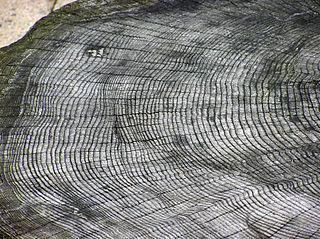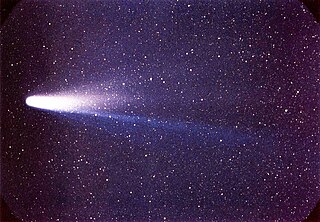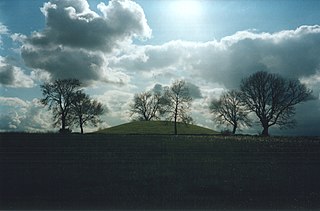Related Research Articles
The zodiacal light is a faint glow of diffuse sunlight scattered by interplanetary dust. Brighter around the Sun, it appears in a particularly dark night sky to extend from the Sun's direction in a roughly triangular shape along the zodiac, and appears with less intensity and visibility along the whole ecliptic as the zodiacal band. Zodiacal light spans the entire sky and contributes to the natural light of a clear and moonless night sky. A related phenomenon is gegenschein, sunlight backscattered from the interplanetary dust, appearing directly opposite to the Sun as a faint but slightly brighter oval glow.

Year 540 (DXL) was a leap year starting on Sunday of the Julian calendar. In the Roman Empire, it was known as the Year of the Consulship of Iustinus without colleague. The denomination 540 for this year has been used since the early medieval period, when the Anno Domini calendar era became the prevalent method in Europe for naming years.

Dendrochronology is the scientific method of dating tree rings to the exact year they were formed in a tree. As well as dating them, this can give data for dendroclimatology, the study of climate and atmospheric conditions during different periods in history from the wood of old trees. Dendrochronology derives from the Ancient Greek dendron, meaning "tree", khronos, meaning "time", and -logia, "the study of".

Halley's Comet, Comet Halley, or sometimes simply Halley, officially designated 1P/Halley, is a short-period comet visible from Earth every 75–79 years. Halley is the only known short-period comet that is regularly visible to the naked eye from Earth, and thus the only naked-eye comet that can appear twice in a human lifetime. It last appeared in the inner parts of the Solar System in 1986 and will next appear in mid-2061.

The Irish Famine of 1740–1741 in the Kingdom of Ireland, is estimated to have killed between 13% and 20% of the 1740 population of 2.4 million people, which was a proportionately greater loss than during the Great Famine of 1845–1852.

Immanuel Velikovsky was a Russian-American psychoanalyst, writer, and catastrophist. He is the author of several books offering pseudohistorical interpretations of ancient history, including the U.S. bestseller Worlds in Collision published in 1950. Velikovsky's work is frequently cited as a canonical example of pseudoscience and has been used as an example of the demarcation problem.

The volcanic winter of AD 536 was the most severe and protracted episode of climatic cooling in the Northern Hemisphere in the last 2,000 years. The volcanic winter was caused by at least three simultaneous eruptions of uncertain origin, with several possible locations proposed in various continents. Most contemporary accounts of the volcanic winter are from authors in Constantinople, the capital of the Eastern Roman Empire, although the impact of the cooler temperatures extended beyond Europe. Modern scholarship has determined that in early AD 536, an eruption ejected massive amounts of sulfate aerosols into the atmosphere, which reduced the solar radiation reaching the Earth's surface and cooled the atmosphere for several years. In March 536, Constantinople began experiencing darkened skies and lower temperatures.

An impact winter is a hypothesized period of prolonged cold weather due to the impact of a large asteroid or comet on the Earth's surface. If an asteroid were to strike land or a shallow body of water, it would eject an enormous amount of dust, ash, and other material into the atmosphere, blocking the radiation from the Sun. This would cause the global temperature to decrease drastically. If an asteroid or comet with the diameter of about 5 km (3.1 mi) or more were to hit in a large deep body of water or explode before hitting the surface, there would still be an enormous amount of debris ejected into the atmosphere. It has been proposed that an impact winter could lead to mass extinction, wiping out many of the world's existing species. The Cretaceous–Paleogene extinction event probably involved an impact winter, and led to mass extinction of most tetrapods weighing more than 25 kilograms.

Comet Encke, or Encke's Comet, is a periodic comet that completes an orbit of the Sun once every 3.3 years. Encke was first recorded by Pierre Méchain on 17 January 1786, but it was not recognized as a periodic comet until 1819 when its orbit was computed by Johann Franz Encke. Like Halley's Comet, it is unusual in its being named after the calculator of its orbit rather than its discoverer. Like most comets, it has a very low albedo, reflecting only 4.6% of the light its nucleus receives, although comets generate a large coma and tail that can make them much more visible during their perihelion. The diameter of the nucleus of Encke's Comet is 4.8 km.

A flood myth or a deluge myth is a myth in which a great flood, usually sent by a deity or deities, destroys civilization, often in an act of divine retribution. Parallels are often drawn between the flood waters of these myths and the primaeval waters which appear in certain creation myths, as the flood waters are described as a measure for the cleansing of humanity, in preparation for rebirth. Most flood myths also contain a culture hero, who "represents the human craving for life".

Navan Fort is an ancient ceremonial monument near Armagh, Northern Ireland. According to tradition it was one of the great royal sites of pre-Christian Gaelic Ireland and the capital of the Ulaidh. It is a large circular hilltop enclosure—marked by a bank and ditch—inside which is a circular mound and the remains of a ring barrow. Archeological investigations show that there were once buildings on the site, including a huge roundhouse-like structure that has been likened to a temple. In a ritual act, this timber structure was filled with stones, deliberately burnt down and then covered with earth to create the mound which stands today. It is believed that Navan was a pagan ceremonial site and was regarded as a sacred space. It features prominently in Irish mythology, especially in the tales of the Ulster Cycle. According to the Oxford Dictionary of Celtic Mythology, "the [Eamhain Mhacha] of myth and legend is a far grander and mysterious place than archeological excavation supports".

Dendroarchaeology is a term used for the study of vegetation remains, old buildings, artifacts, furniture, art and musical instruments using the techniques of dendrochronology. It refers to dendrochronological research of wood from the past regardless of its current physical context. This form of dating is the most accurate and precise absolute dating method available to archaeologists, as the last ring that grew is the first year the tree could have been incorporated into an archaeological structure.
The Taurids are an annual meteor shower, associated with the comet Encke. The Taurids are actually two separate showers, with a Southern and a Northern component. The Southern Taurids originated from Comet Encke, while the Northern Taurids originated from the asteroid 2004 TG10, possibly a large fragment of Encke due to its similar orbital parameters. They are named after their radiant point in the constellation Taurus, where they are seen to come from in the sky. Because of their occurrence in late October and early November, they are also called Halloween fireballs. Since 2P/Encke is such a short period comet, the meteors have the slowest impact speed of the annual well-known meteor showers.

Worlds in Collision is a book by Immanuel Velikovsky published in 1950. The book postulates that around the 15th century BC, the planet Venus was ejected from Jupiter as a comet or comet-like object and passed near Earth. The object allegedly changed Earth's orbit and axis, causing innumerable catastrophes that are mentioned in early mythologies and religions from around the world. The book has been heavily criticized as a work of pseudoscience and catastrophism, and many of its claims are completely rejected by the established scientific community as they are not supported by any available evidence.
The Shiva hypothesis, also known as coherent catastrophism, is the idea that global natural catastrophes on Earth, such as extinction events, happen at regular intervals because of the periodic motion of the Sun in relation to the Milky Way galaxy.
Umm al Binni lake is a mostly dry lake within the Central Marshes in Maysan Governorate in southern Iraq. The 3.4 km (2.1 mi) wide lake is approximately 45 km (28 mi) northwest of the Tigris–Euphrates confluence. Because of its shape, location, and other details, it was first conjectured by Sharad Master, a geoarchaeologist, to represent an impact crater. However, these claims have been disputed, with other studies finding subsidence of the underlying rock a more plausible explanation.
David Keys is an English archaeologist. He has been archaeology correspondent for the London based daily paper, The Independent since 1986, as well as a writer on historical climate change, and contributor to television programs on archeological subjects.

The 774–775 carbon-14 spike is an observed increase of around 1.2% in the concentration of the radioactive carbon-14 isotope in tree rings dated to 774 or 775 CE, which is about 20 times higher than the normal year-to-year variation of radiocarbon in the atmosphere. It was discovered during a study of Japanese cedar tree-rings, with the year of occurrence determined through dendrochronology. A surge in beryllium isotope 10
Be, detected in Antarctic ice cores, has also been associated with the 774–775 event. The 774–775 CE carbon-14 spike is one of the several Miyake events and it produced the largest and most rapid rise in carbon-14 ever recorded.

The Late Antique Little Ice Age (LALIA) was a long-lasting Northern Hemispheric cooling period in the 6th and 7th centuries AD, during the period known as Late Antiquity. The period coincides with three large volcanic eruptions in 535/536, 539/540 and 547. The volcanic winter of 536 was the early phenomenon of the century-long global temperature decline. One study suggested a global cooling of 2 °C (3.6 °F).
The mid-24th century BCE climate anomaly is the period, between 2354–2345 BCE, of consistently, reduced annual temperatures that are reconstructed from consecutive abnormally narrow, Irish oak tree rings. These tree rings are indicative of a period of catastrophically reduced growth in Irish trees during that period. This range of dates also matches the transition from the Neolithic to the Bronze Age in the British Isles and a period of widespread societal collapse in the Near East. It has been proposed that this anomalous downturn in the climate might have been the result of comet debris suspended in the atmosphere.
References
- ↑ Baillie, M.G.L. (2007). Tree-Rings Indicate Global Environmental Downturns that could have been Caused by Comet Debris, Chap. 5 in Bobrowsky, Peter T. and Hans Rickman (eds.), Comet/Asteroid Impacts and Human Society: An Interdisciplinary Approach, Springer-Verlag, Berlin. ISBN 3-540-32709-6, pp. 105-122.
- ↑ Bailey, M.E., S.V.M. Clube and W.M. Napier (1990). The Origin of Comets, Pergamon, Oxford. ISBN 0-08-034859-9, pp. 72-78.
- ↑ "Tree-ring patterns are intellectual property", The Guardian , 11 May 2010.
- ↑ "Climate sceptics force Queen’s University to hand over data", The Times , 20 April 2010.
- ↑ "University told to hand over data", BBC News, 15 April 2010.
- ↑ "Queen's ordered to release tree data", Belfast Telegraph , 1 May 2010.